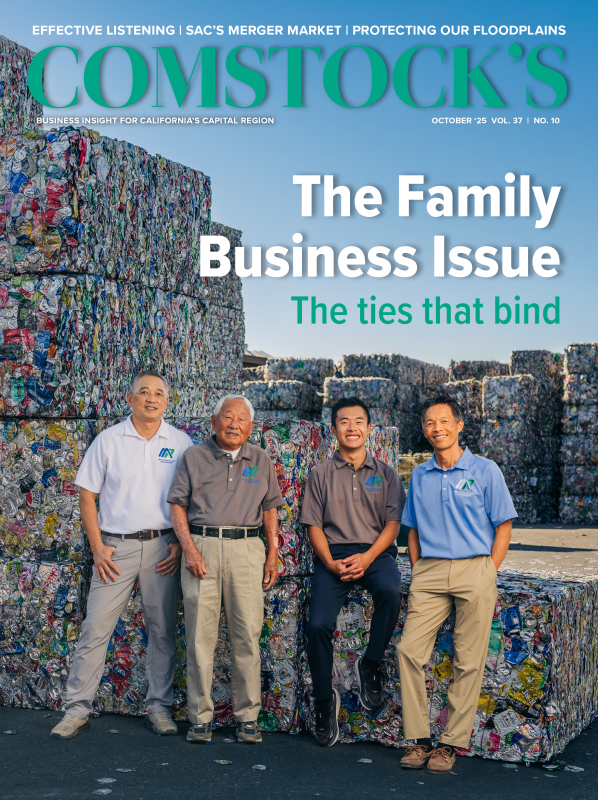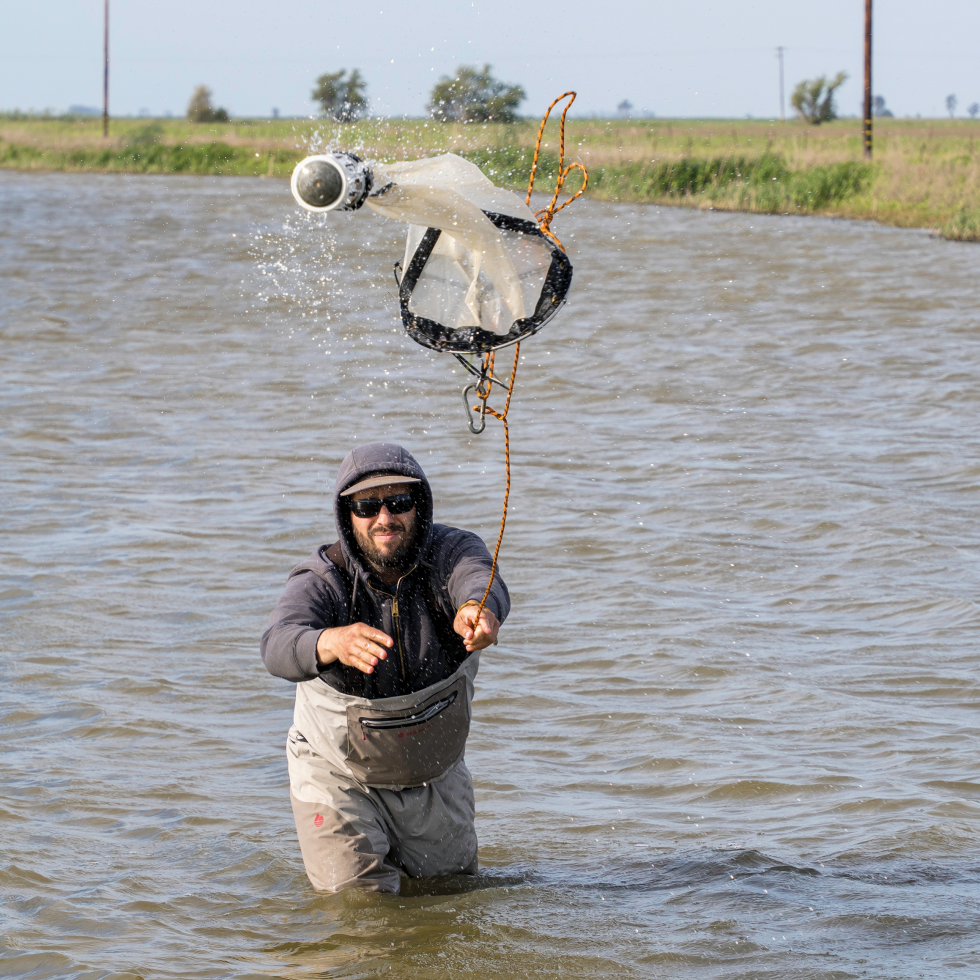This story is part of our October 2025 issue. To read the print version, click here.
Water policy in California is defined by fighting. Water
agencies, farmers, cities and environmentalists argue over every
last drop available in the state’s overdrawn water system. Plans
to fix the system languish for decades, and if they’re
implemented, they end up in court for many more years. The
Floodplain Forward Coalition has broken out of that paradigm.
Floodplain Forward brings together conservation groups such as
Audubon, California Trout and Ducks Unlimited, agricultural
interests such as the California Rice Commission, water providers
and other interest groups to work on some of the state’s biggest
water problems. Members of Floodplain Forward say the stakes are
high in the effort to address issues such as habitat loss for
fish and waterbirds.
To take one high-profile example, the endangered status of the
Chinook salmon has led state officials to consider reducing
agricultural and municipal water use on the Sacramento River
watershed to provide more water for fish.
Gov. Gavin Newsom has advocated greater cooperation generally and
the work of Floodplain Forward specifically as he pushes his
water agenda. The State Water Resources Control Board in July
made his proposal, called the Healthy Rivers and Landscapes
Program, a centerpiece of the draft Sacramento River watershed
plan. The program builds heavily on the work done by Floodplain
Forward.
“I am proud to see the Healthy Rivers and Landscapes Program
represented in this plan update — it’s a testament to
California’s commitment to a collaborative, science-driven
approach to managing our water for the benefit of our
communities, economy, and fish and wildlife, ” Newsom said in a
July news release.
Floodplain Forward uses a spirit of cooperation and cutting-edge
science to improve the health of salmon, other fish and
waterbirds. Farmers need better environmental outcomes to keep
the water flowing to their fields. They also benefit by receiving
payments for use of their land.
Jacob Montgomery of California Trout throws a net to gather bug
samples on a Solano County farm. The bugs are used for fish food.
The idea for Floodplain Forward came out of a
growing awareness of the problems caused by the development of
the Sacramento River watershed, says David Guy, president of the
Northern California Water Association, which has taken the lead
in directing the group’s efforts. Levees and dams were built to
collect water, stop catastrophic flooding and allow the
development of cities and farms. The work helped the region grow
but also dramatically reduced fish and bird habitat.
Guy points to the work of Peter B. Moyle, professor emeritus at
the Center for Watershed Sciences at UC Davis, for providing the
research that helped stakeholders understand the impacts. The
Center for Watershed Sciences is part of the Floodplain Forward
Coalition. One of Moyle’s previous students, Jacob Katz, is now
senior scientist at California Trout and putting those ideas to
use.
The Sacramento and other rivers once flooded a much greater area,
providing fish with more nutrients, Katz says. “The food used to
be on the landscape,” he adds. Now, restricted to narrow river
channels, fish are deprived of essential nutrients.
California Trout has teamed with rice farmers to put water back
on the floodplains. The fields are flooded after harvest,
attracting bugs. The fields are drained, with the bug-rich water
going through channels and into the Sacramento River, where they
provide nutrients for salmon and other fish.
“The magic of Floodplain Forward is the collaboration. You’re
either part of the solution or part of the problem, and rice
farmers want to be part of the solution.”
Tim Johnson, president and CEO, California Rice
Commission
Once they understand the ecology, farmers and other stakeholders
embrace the idea of putting water back on floodplains, Katz said.
The alliances created by Floodplain Forward have surprised some
political insiders. “We went to Washington, D.C., a fish guy, a
water guy, a farmer and a bird guy. These congressional staffers,
their eyes just bugged out, like, ‘What is going on here?’” says
Katz.
“The magic of Floodplain Forward is the collaboration,” says Tim
Johnson, president and CEO of the California Rice Commission.
“You’re either part of the solution or part of the problem, and
rice farmers want to be part of the solution.”
Related: Perspective:
California’s Long and Complicated History With Water
Young salmon are very small when they leave their nesting areas
on tributaries of the Sacramento River. Many of them don’t make
it through the Sacramento-San Joaquin Delta because of problems
with the troubled estuary, including water diversions, pollution
and rising temperatures. Katz and others hope that fattening up
the fish will make them better prepared to handle the threats of
the Delta and make it into the ocean before returning to their
birthplace in the natural life cycle of salmon.
Another way to better feed the fish is to direct them to flooded
floodplains where they can take advantage of the additional food
and grow before resuming their journey to the sea. Katz and
others conducted a study on a rice farm on the Yolo Bypass to
determine the effectiveness of the strategy. Young salmon were
placed on a flooded rice farm after the autumn harvest. They were
marked and measured during a six-week period before being
released.
“The overall rapid growth and robust body condition of the salmon
in this study demonstrates that winter flooding of rice fields
during the agricultural non-growing season can provide high
quality habitat for rearing juvenile Chinook salmon,” the authors
wrote in the 2017 peer-reviewed study.
Montgomery checks the sample to see how many bugs have
accumulated in the water. It typically takes about three weeks to
get the right amount.
A recent project by River Partners, a
nonprofit that is part of Floodplain Forward, brings fish onto
the floodplain. River Partners considers the Willow Bend
Preserve, located near Colusa about an hour north of Sacramento,
a model for salmon recovery. The 175-acre property on the
Sacramento River floods often, which made it hard to turn a
profit when it was a farm.
The flooding often put fish on the land, but there was no
effective way for them to get back in the river. After purchasing
the property, River Partners enlisted Cal Poly San Luis Obispo to
design a “fish gate” that allows fish to move on and off the
preserve when it floods, says Alex Karolyi, a River Partners
spokesperson.
River Partners has observed young salmon using the fish gate
during high-water events on the Sacramento River. Chinook salmon
were the second leading fish observed in 2024, according to a
River Partners report. They were able to eat bugs that
accumulated on the property.
River Partners bought the property from farmers, as it has on
other floodplain restoration projects, including Dos Rios, which
recently became California’s newest state park. The founders of
River Partners were farmers, which makes working with other
farmers a natural fit, Karolyi says.
Conservation groups working cooperatively with farmers is a sharp
turn from the farmers versus environmentalists headlines that
have dominated disputes over fish protection efforts during
recent droughts. Such cooperation also defines Floodplain
Forward’s work in another environmental arena: bird habitat.
Generally speaking, California’s waterbirds are faring much
better than its fish, although they face similar problems because
of habitat loss. Millions of birds migrate along the Pacific
Flyway, which runs between South America and the Arctic, and
spend winters in Central California.
Montgomery releases the bug-filled water into a channel. The bugs
will eventually end up in the Sacramento River, helping to feed
the endangered Chinook salmon.
Some of the habitat needs are filled by
federal and state wildlife refuges. More habitat is provided by
BirdReturns, a program run by three members of Floodplain
Forward: Audubon, the Nature Conservancy, and Point Blue
Conservation Science. BirdReturns pays farmers to temporarily
flood their fields for the birds. The program focuses on farms in
the Sacramento Valley.
“The current way that water is managed across the valley has
disrupted natural flow patterns that may have otherwise created
wetland habitat that could support these birds,” says Xerónimo
Castañeda, working lands program director for Audubon California.
Partnering with 200 growers and wetland managers, BirdReturns has
delivered $6 million in direct payments to landowners while
creating essential habitat for migrating birds in California,
says Lishka Arata, a Point Blue spokesperson. Ducks Unlimited has
received a federal grant to explore further incentives for rice
farmers who could provide waterbird habitat.
Related: The Lasting
Agreement: California’s long legacy of trying to solve its water
problem
The northern pintail, one of the most common migratory waterbirds
in Central California, travels 2,000 miles nonstop from
California to Alaska, where they breed, notes Jeff McCreary,
director of operations for Ducks Unlimited’s Sacramento office.
“That’s why Ducks Unlimited is interested in making sure we
always have rice on our landscape, because that’s how they make
their journey — fed by rice,” he says. The rice fields are
flooded for birds after harvest. But the fields still contain
rice and rice byproducts for the birds.
Habitat restoration is central to the plan put forward by Newsom
and others as an alternative to an earlier proposal by the staff
of the State Water Resources Control Board that would reduce
water diversions from the Sacramento River watershed. The
“Agreements to Support Healthy Rivers and Landscapes” call for,
among other things, “floodplain restoration and seasonal flooding
of agricultural land. Restoration actions for floodplain habitats
in the Bypasses and in the Delta involve providing access to
improved and diversified rearing habitat conditions on a seasonal
basis for a wide variety of native fish species.”
The Northern California Water Association is one of the parties
that signed the agreements, along with water agencies, farming
interests and other government agencies. The association calls
the agreements a “model for cooperation” that “provides the
opportunity to take a collaborative approach with diverse parties
from Red Bluff to San Diego,” according to promotional material
from the association.
Some environmental groups oppose the proposal because they say it
would not provide enough water for fish. The State Water
Resources Control Board, which is appointed by the governor,
voted in July to include the governor’s proposal in its draft
plan, which will go through public hearings before final
approval.
–
Stay up to date on business in the Capital Region:
Subscribe to the Comstock’s newsletter
today.





